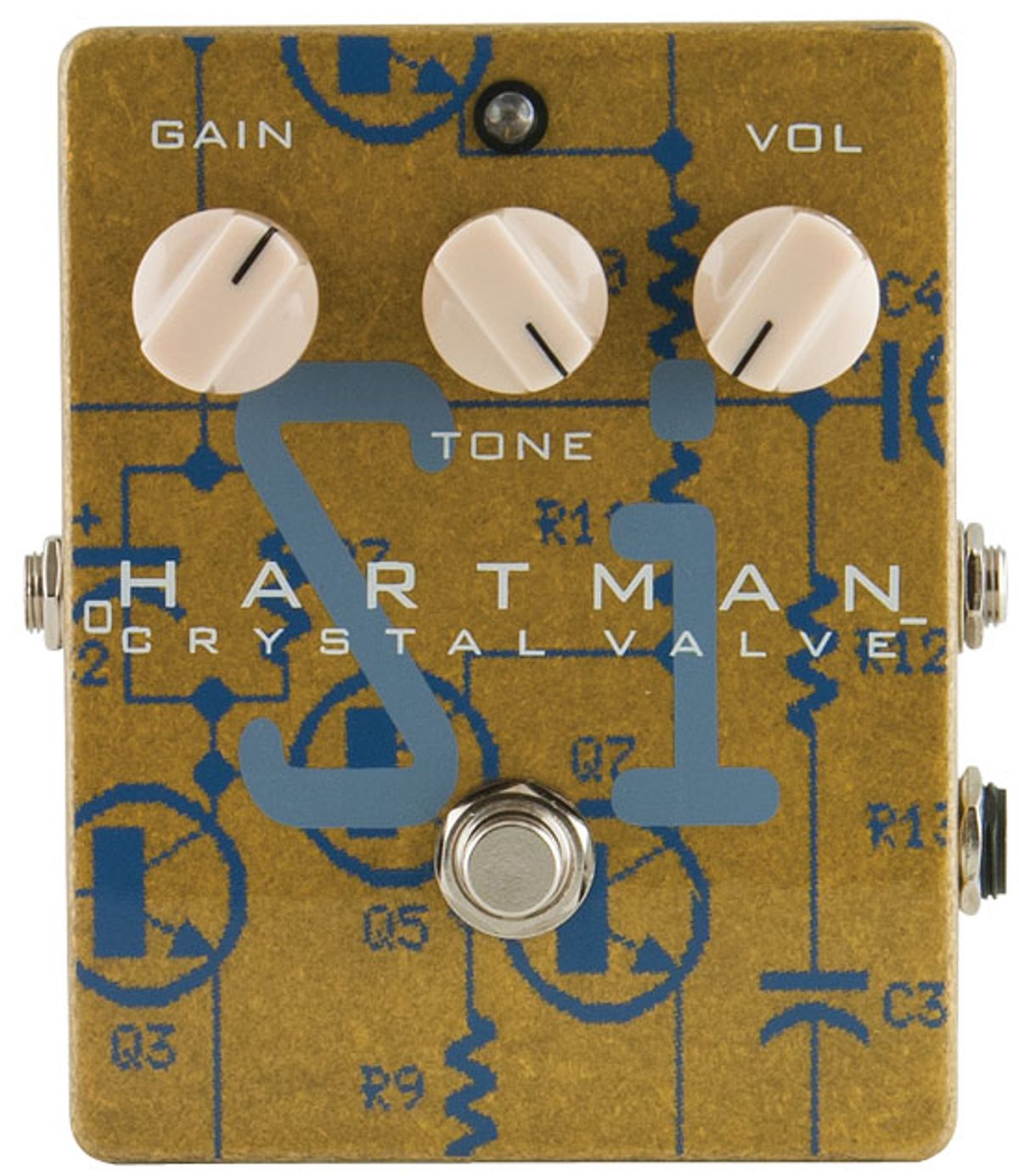
The new Silicon Crystal Valve from Hartman Electronics is based in significant measure to the Colorsound Supa Tone Bender, and like the original, it’s a cool twist on a classic sound that’s full of unique fuzz flavors.
Controls at noon, then max, then Gain max & Tone 8 o'clock (Fender Jaguar & Fender Tremolux)
Had the ancient Egyptians erected a temple to fuzz, the Tone Bender and Big Muff would be two sides of the pyramid. Apart from being legendary in their earliest and most basic forms, they have each spawned almost innumerable iterations, copies, spin-offs, and re-imaginations—many of which have become classics in their own right. One of the more curious offspring of the Tone Bender or Big Muff, the Colorsound Supa Tone Bender has the unique distinction of being related—albeit via a rather twisted path—to both. For while the Supa Tone Bender was a Tone Bender in name and was built by the Colorsound/Sola Sound company that had built the first and most famous versions of the Tone Bender, the circuit itself was inspired by the Big Muff.
Sonically speaking, the Colorsound Supa Tone Bender was much closer to a Muff than a Tone Bender. In fact, save for a missing first-stage clipping diode and a few other components, it was a copy of a Ram’s Head-era Big Muff. But the absence of that diode made the Supa Tone Bender a very different kind of Muff indeed. The new Silicon Crystal Valve from Hartman Electronics is based in significant measure to the Supa Tone Bender. And like the original, it’s a cool twist on a classic sound that’s full of unique fuzz flavors and arguably more flexible and multifaceted than a lot of old Muffs.
Built for the Long Haul
Though the template for the Silicon Crystal
Valve is about 40 years old, Hartman doesn’t
make the pedal a retro exercise, at least
outwardly. Instead, it’s dressed up in more
contemporary graphics—a swatch of circuit
schematic that’s overlaid with the periodic-table
shorthand for silicon that, like a lot
of modern tech-inspired graphics, becomes
pretty jumbled and vague. In fact, in low
stage-light, it’s a little hard to make out
the gain, tone, and volume labels amid the
clutter. Yeah, a three-knob fuzz isn’t rocket
science, but on a crowded pedalboard, even the most intuitive pedals benefit from clear
labeling. And why not be bold and have a
little more fun—especially with that cool,
glossy gold-flake paint as a blank slate.
Inside, however, the Hartman is the essence of streamlined. The circuit board (built around four NPN silicon transistors) is flawlessly put together, solders are clean, components are locked down tight and free of rattles or play, and the interior of the enclosure is clear coated. All of these very nice details reflect a concern for quality, durability, and the realities of frequent, real-world touring and stage use. On the exterior, it’s more of the same. The knobs move with a near perfect resistance that prevents you from knocking your settings out of whack if you graze the pedal with your shoe, but still move easily enough to adjust with your toe in the middle of a solo if you have to. The switch work and jacks are all top-quality, rugged stuff, and the LED, while bright enough to blind you, eliminates any doubt about whether the pedal is off or on.
Bee’s Buzz, Lion’s Roar
One of the coolest facets of the Silicon
Crystal Valve’s performance is that while it
owes much of its genetic makeup and sonic
signature to the Big Muff, it exhibits many
of the best qualities of a good Tone Bender
too—cutting, buzzy, and a lot of bite in
the midrange. Much of that shape-shifting
ability comes down to a basic fuzz voice
that’s full, muscular, and aggressive, but not
bogged down by too many lower-octave
overtones the way some Big Muffs are. The
less-woofy voice that it generates will work
with a greater variety of guitars in more
musical settings. A Telecaster and Deluxe
Reverb are as well suited to the Silicon Crystal Valve’s voice as a beefy Wide Range
humbucker and a Marshall.
Ratings
Pros:
Wide range of unique, silicon fuzz tones. Exceptional attention to construction detail.
Cons:
May not have enough gain or output for some modern fuzz players.
Tones:
Ease of Use:
Build/Design:
Value:
Street:
$179
Company
hartmanpedals.com
In terms of output, the Silicon Crystal Valve is closer to an old Ram’s Head Muff than the bossier Sovtek version, which seems to have become the de facto output standard for a lot of Muff re-issues. You don’t perceive unity gain until about 1 o’clock on the volume side if you have the tone and gain (fuzz) at noon. But as any old Ram’s Head user can attest, this is hardly an obstacle to getting loud and aggressive. In general, the Silicon Crystal Valve sounds a little more compressed than a Big Muff, but you lose surprisingly little in terms of picking dynamics or definition for faster leads. That may not be enough to sway metal fiends that love a Muff’s sledgehammer brutality. But it makes the pedal a much better fit for more melodic and ornate rock leads.
Cranking the gain and volume gives you a sweet but menacing biker-rock grind that retains chord detail and sounds smooth, sonorous, and a bit nasty with a neck pickup, but sounds positively feral and ferocious with a Telecaster’s bridge pickup driving the works. With this setup, you can move between Ron Asheton’s Fun House grind and Mick Ronson’s rip and sting with just a little tweak of the Telecaster’s tone knob.
Open up the gain and tone, roll back the volume to unity, and you get a full but buzzy mid-’60s fuzz that stays buzzy and articulate enough for chording, a sweet spot not a whole lot of fuzzes can achieve. The tone control’s sweep is wide and effective, which not only enables moves from psychedelic sizzle to more civilized fuzz realms fast, but also makes this a great pedal for recording sessions. You can easily tailor the Silicon Crystal Valve to fit a mix without much hassle, and the menu of flavors available via these three simple knobs is surprisingly expansive.
The Verdict
With the lack of any real star associations, you
don’t see many companies exploring the Supa
Tone Bender as a point of departure. Hartman,
however, has created something unique and
genuinely exciting from the recipe—no mean
feat in a crowded fuzz market. Big Muff dogmatists
may find the pedal a too-considerable
deviation from the form. Tone Bender and Fuzz
Face devotees may find it too Muff like. But the
fact is that crafty players that don’t mind digging
in and twisting knobs to their extremes will find
plenty of colors that are evocative of all three
fuzz types—and a whole lot more. For what you
may not get in mega-tonnage with the Silicon
Crystal Valve, you get in myriad shades of musicality.
And if you’re looking to shape your own
fuzz sound, this is a great place to start.

